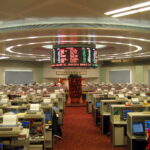The European Central Bank reduced the key interest rate on Thursday by 25 basis point, citing an easing of inflation as well as increased risks for economic growth due to trade tensions and pessimism among businesses.
Most people expected the move to be made.
The ECB has cut rates seven times in the last year to try and support the Eurozone’s economy, despite an increasingly unstable global environment.
This is the first time since early 2023 that the ECB has lowered its deposit rate.
The bank is also concerned about the fading business confidence, and economic impact of tariffs placed by the United States.
The central bank stated in its statement on monetary policy that “the euro area has built up some resilience to global shocks but the outlook has deteriorated due to increasing trade tensions.”
“Increased insecurity is likely to decrease confidence among householders and businesses”
The ECB has changed its language and dropped the earlier statement that rates of interest were “significantly less restrictive”. It now acknowledges that a number of factors may have a greater impact on the economic prospects for the eurozone.
The increased uncertainty will likely reduce the confidence of households and businesses, while the negative and volatile response from the market to trade tensions may have an impact on the financing conditions. The euro zone’s economic outlook may be further impacted by these factors,” the report said.
This shift is a reflection of the central bank’s belief that the current rate ranges are at the higher end of its definition for “neutral”, i.e. a rate which neither stimulates nor inhibits growth.
Although this neutral range has been loosely set between 1.75 and 2.25 percent, the policy makers have made it clear that they are not using a standard benchmark.
The ECB does not provide clear direction while the markets are pricing in two additional cuts
Despite its rate reduction, the ECB did not provide any clear direction on how to proceed.
It reaffirmed, instead, that decisions will be taken at each meeting, based on the economic indicators.
The financial markets have priced in two additional rate cuts for 2025. Some analysts even see room to cut a third if US Tariffs and the global financial instability continue to weigh down on eurozone’s economy.
During her press conference, Christine Lagarde will be expected to highlight these risks.
She estimated previously that the trade tensions, and the confidence shock they caused, could reduce growth in Europe by as much as a half-point — an important hit to a region which is already experiencing modest growth.
Lagarde will also note that inflationary pressures have eased since the ECB’s March meeting.
The threat of inflation has been reduced by a stronger euro, lower energy prices and slower growth.
She could also mention that Chinese exports may further lower global prices, if US Tariffs Force Beijing to Redirect Goods to Europe and Other Markets.
Euro falls from its highs, but still holds gains
The euro fell to $1.13 after the ECB announced its decision. It has fallen from the recent highs, last seen at the beginning of 2022.
The currency is still up about 5% over the past few months against the US dollar, boosted by a shift in investor sentiment as well as expectations that defence spending will increase in Germany and other countries.
As policymakers balance a delicate balancing act between protecting the economy and stabilizing inflation, they will closely monitor what steps ECB takes next.
The post ECB lowers rates 25 bps on inflation, warns that trade tensions could cloud the growth forecast may be updated as new information becomes available
This site is for entertainment only. Click here to read more





